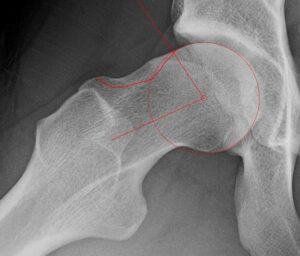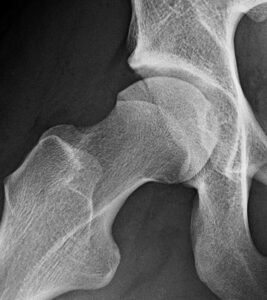Femoroacetabular Impingement in the Hip Treated in Arlington, VA

Figure 1: Right hip showing severe cam-type FAI with an alpha angle of 80 degrees.
Over the last three decades, research has enhanced the understanding of painful hip conditions and revolutionized their treatment. Before the advent of hip replacement surgery, the standard response was “grab a cane and take some pain relievers.” Then, as surgical techniques and technologies advanced, the response changed to “wait until it gets bad enough, then have a hip replacement.”
Although hip replacement surgery is an excellent option for many people, it is not right for everyone, particularly those who are young, active and do not have severe arthritis. For example, femoroacetabular impingement (FAI) is a painful hip condition that is being diagnosed with increasing frequency in young patients. But there is a growing consensus that many older people who are opting for hip replacement surgery have arthritis caused by FAI.
What Is FAI?
Also known as hip impingement, FAI is a condition in which extra bony tissue grows on one or both bones that form the hip joint. As a result, the bones do not fit perfectly together, and excessive contact occurs between the upper end of the thighbone (femoral head) and the large pelvis bone (acetabulum) during movement.
Additionally, the acetabulum is lined with a rim of cushioning cartilage (labrum), which provides a suction seal and joint stability. Many experts believe that FAI can cause labral tears and hasten the onset of degenerative arthritis.
What Are the Symptoms of FAI?
The most common sign of FAI is groin pain during hip movement, particularly in positions of flexion, adduction and internal rotation. The symptoms can be achy and chronic or sharp and mechanical. Some people also have:
- Buttock pain (similar to sciatica)
- Lower abdominal pain (similar to a sports-related hernia)
- Medial groin pain (similar to an adductor or iliopsoas strain or tendinitis)
- Lateral hip pain (similar to trochanteric bursitis)
How Is FAI Treated?

Figure 2: Right hip after hip arthroscopy FAI surgery. A normal alpha angle has been restored and the hip shape is now normal.
Many patients begin FAI treatment with a combination of activity modifications, nonsteroidal anti-inflammatory drugs (NSAIDs) and physical therapy to stretch and strengthen their core muscles and enhance their hip range of motion. In some cases, the sparing use of corticosteroid injections can also be beneficial.
If conservative treatment does not provide adequate relief, surgical options may be considered. The goals of surgery are to remove the excess bony tissue and, if necessary, to repair or debride the labral tear. Historically, FAI surgery was performed as an open procedure in which exposure to the hip required a large incision, an osteotomy of the greater trochanter and a surgical hip dislocation. While this surgical approach can provide a good result, it is usually followed by a long and difficult recovery.
With the advent of improved arthroscopic techniques and technology, it is now possible to perform FAI surgery by passing a miniature camera and specialized surgical instruments through small incisions. The surgeon can then remove excess bone with an arthroscopic burr and repair the torn labrum using arthroscopic suturing techniques. This is a proven successful treatment for hip FAI and can result in significant long-term improvement. Notice the dramatic improvement in hip correction possible with hip arthroscopy (figures 1 and 2).
If you would like to learn more about treatment options for FAI, contact Nirschl Orthopaedic Center at (703) 525-2200 to request an appointment with a hip arthroscopy specialist in Arlington, VA.
